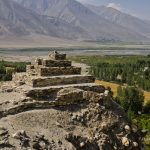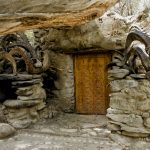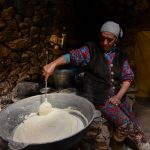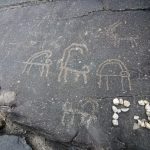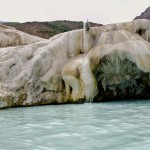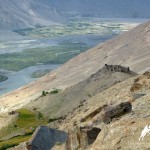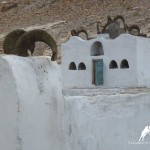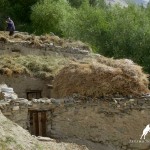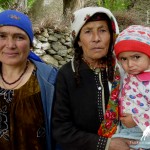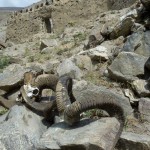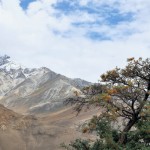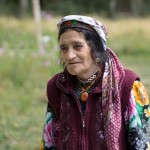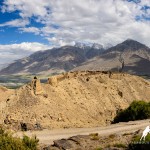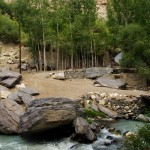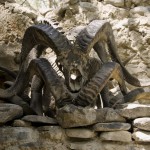Petroglyphs, a type of carved rock art engraving, were once commanding cultural symbols for the ancient tribes who lived in the Pamir Mountains of Tajikistan. These intricate drawings were chipped away into rocks and stones and used to express everyday life in the mountains. They were carved into low terraces, on burial sites, the walls of fortresses, on riverbanks and lakeshores, in hunting zones, and within the ruins of ancient settlements like the Ratm fortress. Basically any surface that shone in the sun and could be easily engraved upon was suitable for an ancient petroglyph.
oday, there are over 50 different petroglyph sites within the Pamir Mountains of the Silk Road – the highest concentration of rock art sites in Tajikistan. Dating back centuries upon centuries, the Pamir petroglyphs often portrayed animal hunting scenes of wild goats, ibex, yaks, and deer as well as everyday routines and important religious ceremonies.
The different groups of Pamir Petroglyphs, Tajikistan, are located in different areas and were created at different time periods using ancient tools to whittle away at the natural rock. Unlike ancient pictographs that are usually images painted on the rocks, petroglyphs are carved and chipped away into the rocks’ surface instead. The oldest Pamir petroglyphs date back to the Bronze Ages while the more recent are from the early Middle and Modern Ages.
You will find some great examples of age-old petroglyphs in the Pamirs and in other areas of Tajikistan; some are more easily reached or better preserved than others. Some of the best Tajik River, along the Panj River (or Pyandzh River), beside the Bartang River’s estuary, along the Yaghnob River, and tucked within the rocky slopes above the villages of Porshnev, Shohdara, North Akdzhilga, Yazghulom, and Langar, Tajikistan.
The highest concentration of petroglyphs in Tajikistan can be found in the mountains above the village of Langar in the Ishkashim District. This is the easternmost settlement in the Western Pamir Plateau and its isolation can be felt. There are over 6,000 ancient petroglyphs and pictographs carved into granite rocks here in the upper part of the Wakhan Valley.
Seeing all of the Langar rock art sites on one trip is an ambitious adventure as they are scattered throughout the valley from the slopes of the Shohdara Valley all the way to the watershed. Fortunately, you do not need to see them all as the Langar petroglyphs all follow a similar theme: mountain goats, ibex, hunting scenes and a traditional musical instrument known as a rubob. Nearby, the fortress Ratm petroglyphs are also worth a visit.
Another example of remarkable petroglyphs in Tajikistan is the Vybistdara petroglyphs. Situated around seven kilometers from the Debasta village, it consists of four groups of petroglyphs that date back as far as the 1st-century BC. What is unusual about these rock paintings is that, unlike the rest of the petroglyphs in the Pamir Mountains that show predominantly pictures of animal hunting scenes, the majority of the Vybist-Dara petroglyphs are drawings of humans.
Another interesting rock art site in the Pamirs of Tajikistan is the Nayzatash petroglyphs in the Murgab District. As they are different to the rest of the Pamir petroglyphs in Tajikistan, they are thought to date back to a different time, possibly the Neolithic period but even archaeologists do not know for sure.
At least five more ancient petroglyphs can be found carved into the black shale mudstones of the Ak-Jilga (or Akjilga) gorge in the Murgab District’s Alichur valley. Located 3,800 meters above sea level in the East Pamirs of Tajikistan, the Oqjilga petroglyphs, also known as the Alichur Petroglyphs and the Akdzhilga petroglyphs, are some of the highest petroglyphs in Central Asia. Dating back to the Bronze Ages, the Akdzhilga engravings are also some of the oldest petroglyphs Tajikistan has to offer. Here, the petroglyph carvings portray a man with a bow and arrow and a pointy hat as well as wild goat hunting scenes and the horse-driven chariots that were a common Central Asian theme.
Some of the most recently discovered petroglyphs in Tajikistan can be found along the Yaghnob River. They were found in 2007 at the entrance to the river in the Tang-i Dahona gorge. Some of them are located in the river itself, partially submerged, while others can be found on the slopes above it. These rock engravings are mainly of ibex and hunters with long spears and some of them also include short inscriptions and what appears to be a swastika.
A large collection of 10 rock art sites known as the Sai Mosrif petroglyphs have been found at the right tributary of the Shing River in Tajikistan. As with many of the Tajikistan’s petroglyphs, they include images of goats, hunters, a dog and even a camel. Still larger concentrations of rock engravings were found in a limestone cave above the village of Gizhdarva at an altitude of 2,200 meters.
Other petroglyphs sites across the rest of Tajikistan include the Dashti Eymatk petroglyphs near the village of Urmetan on the banks of the Zerafshan River, the Vagishton petroglyphs along the banks of the Vagishton Sai in the Pyandzhikent District, and the Soy Sabag petroglyphs in the Soghd province of Tajikistan.
While these Tajikistan petroglyphs are fascinating to look at, they have been shrouded in mystery for hundreds and even thousands of years. Even today, they still are. Nobody really knows what the petroglyphs of the Pamirs meaning or purpose truly was. Whether they had religious connotations or were just a form of ancient expression or communication, we will never know. But they certainly are fascinating to view either way.
As many of these ancient rock drawings in Tajikistan, particularly the petroglyphs in Langar, are hidden on the rocky slopes of desolate valleys, they can be just about impossible to find on your own. That is why we recommend planning your visit to the petroglyphs in the Pamir Mountains of Tajikistan with an expert local guide with Paramount Journey. You can also combine your trip with any other tour or itinerary along the Pamir Highway, such as a visit to the nomadic tribes of the Pamirs or the hot springs of the Wakhan Valley. Take a look at our tours and itineraries for more information!






